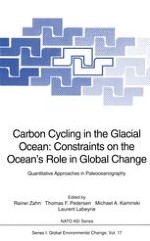1994 | OriginalPaper | Buchkapitel
Late Quaternary PCO2 Variations in the Angola Current: Evidence from Organic Carbon δ13C and Alkenone Temperatures
verfasst von : Peter J. Müller, Ralph Schneider, Götz Ruhland
Erschienen in: Carbon Cycling in the Glacial Ocean: Constraints on the Ocean’s Role in Global Change
Verlag: Springer Berlin Heidelberg
Enthalten in: Professional Book Archive
Aktivieren Sie unsere intelligente Suche, um passende Fachinhalte oder Patente zu finden.
Wählen Sie Textabschnitte aus um mit Künstlicher Intelligenz passenden Patente zu finden. powered by
Markieren Sie Textabschnitte, um KI-gestützt weitere passende Inhalte zu finden. powered by
The δ13C record for organic carbon in Late Quaternary sediments of the Eastern Angola Basin shows a pronounced cyclicity with high values (-18.3 to -20‰) in glacial isotopic stages 2 to 4 and stage 6, and lower values (-20 to -21.2‰) in interglacial stages 1 and 5. Seasurface temperatures, derived from the alkenone Uk37 index, vary in the opposite sense, ranging from 20–22°C in glacial stages up to 24–26°C in interglacial stages. The inverse relationship between δ13Corg and SST values suggests that the isotopic variations are not due to temperature-dependent isotopic fractionation during photosynthesis, in which case δ13Corg values would be expected to increase with increasing temperature. Relationships between sedimentary δ13Corg and C/N ratios indicate that differing proportions of marine and terrigenous organic matter can also be ruled out as a cause for the δ13Corg variability. Instead we conclude that changes in surface water CO2 concentrations were responsible for the observed glacial to interglacial isotopic variations.Employing the relationships between planktonic δ13Corg and dissolved CO2(aq) derived by POPP et al. (1989) and RAU et al. (1989) we estimate that the partial pressure of carbon dioxide (PCO2) in the surface water of the Angola Current (AC) has been consistently higher than values given by the Vostok atmospheric CO2 record for the last 160,000 years. This indicates that the AC has generally acted as a source region for atmospheric CO2 throughout this period, which is consistent with the modern situation. However, the difference between surface-water and atmospheric pCO2 was larger in interglacial (pCO2 ≈ 100–120 µatm) than in glacial times (mean pCO2 ≈ 70 µatm). This suggests that the AC was a weaker CO2 source during glacial periods, presumably due to lower sea-surface temperatures and higher biological productivity.
